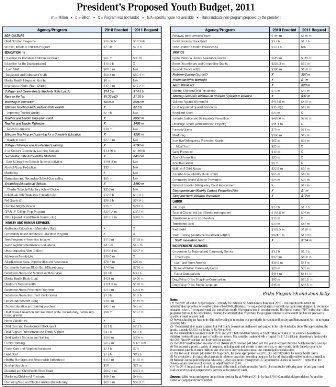A proposed appropriation of $210 million for Promise Grants – the Obama administration’s program to replicate the successful Harlem Children’s Zone approach to child development – is one of the largest new youth-directed programs in the president’s fiscal 2011 budget sent to Congress last month.
The current budget contains $10 million for planning grants for possible
|
Click image to download |
Promise Neighborhoods. The $210 million in next year’s budget includes $200 million for an unspecified number of demonstration projects and $10 million for additional planning grants, signaling a possible second round of demonstration projects next year.
While the president’s budget includes increases in many programs, there are also deep cuts, prompting complaints from various advocacy groups.
The Afterschool Alliance decried cuts in various after-school programs, calling the budget a “bitter disappointment.” The 21st Century Community Learning Centers program, the primary conduit for after-school programs, is level-funded in the 2011 budget.
“The president’s proposal to divert funds from after-school programs by putting them in competition for grants with the Full Service Community Schools Program will effectively cut the funding available for the after-school programs that children and families across the nation rely upon,” the alliance said in a statement.
On the other hand, Lauren Asher, president of the Institute for College Access and Success, praised the budget’s inclusion of “concrete and cost-effective proposals to make college more affordable.” She specifically praised plans to streamline the student loan programs by making direct loans to students.
Among the budget details:
Corporation for National and Community Service: Appropriations for AmeriCorps state and national programs would jump by more than 30 percent, allowing expansion to 105,000 members. The appropriation for the educational awards would rise about 50 percent, from $197 million to $293.6 million, reflecting both the increased AmeriCorps membership numbers and a rise in the amount of the award.
President Barack Obama has vowed to expand AmeriCorps membership to 175,000 by 2017. There were slots for about 75,000 members of AmeriCorps when he took office.
Overall, the budget for the corporation would grow from $1.15 billion to $1.416 billion, with increases in Learn and Serve America (from $39.5 million to $40.2 million), the National Civilian Community Corps (from $19 million to $34.6 million) and the Social Innovation Fund ($50 million to $60 million).
Labor: YouthBuild funding would rise from $102.5 million to $120 million under the president’s proposed budget, allowing expansion to 230 locations.
The Labor Department would introduce two new youth initiatives: $108 million to pursue “learn and earn” strategies such as apprenticeships and on-the-job training, and a $154 million Youth Innovation Fund for pilot summer programs and year-round job programs for disconnected youth.
Health and Human Services: The Teen Pregnancy Initiative would rise by $19 million, to $129 million; adoption incentive, opportunity and awareness programs would increase from $78.7 million to $93 million, and child abuse prevention and treatment would increase from $94 million to $107 million.
Substance abuse prevention programs would grow from $202 million to $223 million, but the administration announced that total funding for drug prevention would rise to $15.5 billion and include $150 million in new funding for a community-based program to prevent adolescent drug use and extend addiction treatment and aftercare, along with the training needed to support such a program.
Justice: Mentoring grants drop from $100 million to $45 million; Byrne Discretionary and Competitive grants fall from $225.3 million to $30 million; Missing Children/Child Exploitation funding drops from $70 million to $60 million; and the Weed and Seed program is zeroed out.
At the same time there are new initiatives, including the Attorney General’s Initiative on Children Exposed to Violence. More on the justice budget appears under JJ Today at http://www.youthtoday.org.
Education: The biggest jump for all youth programs is in the amount requested for Pell grants, which help low-income students attend college. The Obama administration is again asking that the grants be made a federal entitlement, which means funding for them would rise automatically rather than the current system of having to be appropriated each year. Obama is requesting that funding for the program rise to $34.9 billion from the current $26.9 billion. The amount represents a rise in the maximum amount of a Pell grant, from the current $5,550 to an estimated $6,900 in 2019.

























